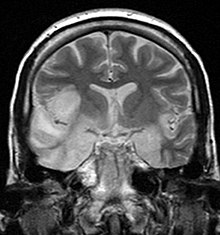User:Mr. Ibrahem/Herpesviral encephalitis
| Herpesviral encephalitis | |
|---|---|
| Other names | Herpes simplex encephalitis (HSV encephalitis) |
 | |
| Coronal T2-weighted MR image shows high signal in the temporal lobes including hippocampal formations and parahippogampal gyrae, insulae, and right inferior frontal gyrus due to HSV encephalitis. | |
| Specialty | Emergency medicine, neurology |
| Symptoms | Headache, fever, confusion, weakness[1] |
| Complications | Autoimmune encephalitis[2] |
| Causes | Herpes simplex virus[1] |
| Diagnostic method | Based on symptoms, cerebral spinal fluid analysis, MRI[2] |
| Differential diagnosis | Other causes of encephalitis, meningitis, neurosyphilis[1] |
| Treatment | Acyclovir[2] |
| Prognosis | 66% have ongoing disability[3] |
| Frequency | Rare[1] |
Herpesviral encephalitis is inflammation of the brain due to the herpes simplex virus.[1] Symptoms commonly include headache, fever, confusion, and weakness.[1] Less commonly neck stiffness and abnormal speech may occur.[1] Onset is generally over a couple of days.[1] Complications can include seizures, diabetes insipidus, and autoimmune encephalitis.[4][2]
It most commonly occurs due to herpes simplex virus-1 (HSV-1), with less than 10% of cases due to herpes simplex virus-2 (HSV-2).[1][4] About a third of cases occur as an initial infection, while two thirds occur as a recurrence; though only 10% have a history of cold sores.[3] Diagnosis is generally based on symptoms, supported by cerebral spinal fluid analysis and MRI.[2]
Treatment is with acyclovir.[2] Anticonvulsants may be used to decrease the risk of seizures.[1] The disease is most severe in the young and the old.[4] About 20% experience significant long term disability.[4] The risk of death is between 1% and 8%.[2]
Herpesviral encephalitis is rare, affects about 1 in 100,000 newborns, 1 in 400,000 children, and 1 in 150,000 adults in the United States.[2][1] Males and females are affected with similar frequencies.[1] About half of cases develop in those over the age of 50.[5] It is the most common cause of infectious encephalitis in the developed world.[2] The disease was first described in humans in 1935.[6]
References[edit]
- ^ a b c d e f g h i j k l "Encephalitis, Herpes Simplex". NORD (National Organization for Rare Disorders). Archived from the original on 21 March 2021. Retrieved 13 June 2021.
- ^ a b c d e f g h i Stahl, JP; Mailles, A (June 2019). "Herpes simplex virus encephalitis update". Current opinion in infectious diseases. 32 (3): 239–243. doi:10.1097/QCO.0000000000000554. PMID 30921087.
- ^ a b Whitley RJ (September 2006). "Herpes simplex encephalitis: adolescents and adults". Antiviral Research. 71 (2–3): 141–8. doi:10.1016/j.antiviral.2006.04.002. PMID 16675036.
- ^ a b c d AK, AK; Mendez, MD (January 2021). "Herpes Simplex Encephalitis". PMID 32491575.
{{cite journal}}: Cite journal requires|journal=(help) - ^ Whitley RJ, Gnann JW (February 2002). "Viral encephalitis: familiar infections and emerging pathogens". Lancet. 359 (9305): 507–13. doi:10.1016/S0140-6736(02)07681-X. PMID 11853816. S2CID 5980017.
- ^ Grove, David (2013-12-19). Tapeworms, Lice, and Prions: A compendium of unpleasant infections. OUP Oxford. p. 496. ISBN 978-0-19-165344-5. Archived from the original on 2021-08-29. Retrieved 2021-06-13.
